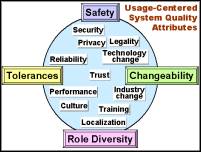Subtle but important tradeoffs in four key areas
can be critical to success
We’re all familiar with software that crashes, is insecure, or is hard to use. Appliances and gadgets that fail even when asked to perform their most common task have frustrated us all. Why is the problem so common?
The issue may be a faulty manufacturing quality control process or software packaging problem. But more likely, failure is in the original requirements and resulting architecture and/or design.
Sometimes called “pervasive attributes” or “ilities” (like reliability), these qualities can almost never be “added on.” Try to add on security, for example, and you face the endless downloads of patches and virus scanning upgrades so familiar to Microsoft Windows users.

Simplified System Quality Attributes Medallion
APConnsulting, LLC believes that every major product or project needs to carry out an initial review to scope out which system quality attributes will be critical and how they might be a factor. This “due diligence” can avoid costly backtracking later in the design or implementation stages. Once the key attributes are identified, they can be explicitly defined and tracked throughout the entire development and manufacturing/delivery process.
We find that most organizations have never considered many key attributes. To help in the process, APConnsulting, LLC has defined four categories of attributes.
- Tolerances: Technologies may perform their functions correctly, but still not “work” because of unpredictable aspects of their operation. Examples are performance and reliability
- Safety: Technology can damage a business or a customer. You have to understand what the risks are in order make the appropriate tradeoffs. The tradeoffs must factor in such things as the value of the assets, the cost of protecting them, the likelihood of an attack, and the chance of successful compromise if there is an attack. Examples are security and privacy.
- Role Diversity: People fill roles, and we can’t always control with whom the product must interact. The range of individuals can be quite wide, depending on the usage paradigm. The success of a product can depend on the size and range of the audience able to use it. Some products must support more than one role (manager versus cashier, vehicle driver versus passenger). Examples include ranges in education and industry expertise, and different localization needs.
- Changeability: Usage is not static; paradigms shift frequently, sometimes almost constantly. Not only does the technology shift, but the usage within an industry can rapidly change as well. How do you keep your “eye on the ball” when everything is shifting?
Some quality attributes seem to fit in more than one category. That is not necessarily a problem—the attribute may simply have more than one dimension that needs to be considered. For example, reliability can refer to robustness under normal use (does it work within the normal tolerances?), but it can also be a factor in security (a denial of service attack can appear to be a reliability problem).
APConnsulting, LLC had created a medallion that presents most of the major quality attributes. We can help you understand which attributes might be important and help you plan for the actual usage context of your product or solution. (Note, the image at the top of the page is an abridged version of the full medallion, showing only some of the attributes.)
Note: The pages on this web site are specifically designed for keyboard navigation, which means that a mouse is never required on this site. Each page is designed to be accessible for individuals with disabilities, particularly those who cannot use a mouse or who use keyboard navigation to reduce repetitive stress injuries.
| • | • | • | • | • | ||||||
Copyright © 2005-2010, Alex Conn, APConnsulting, LLC. All Rights Reserved. www.apconnsulting.com
|
||||||||||
